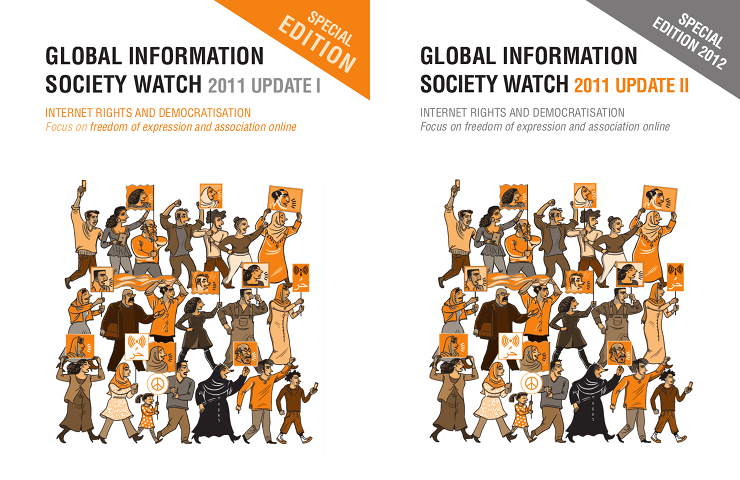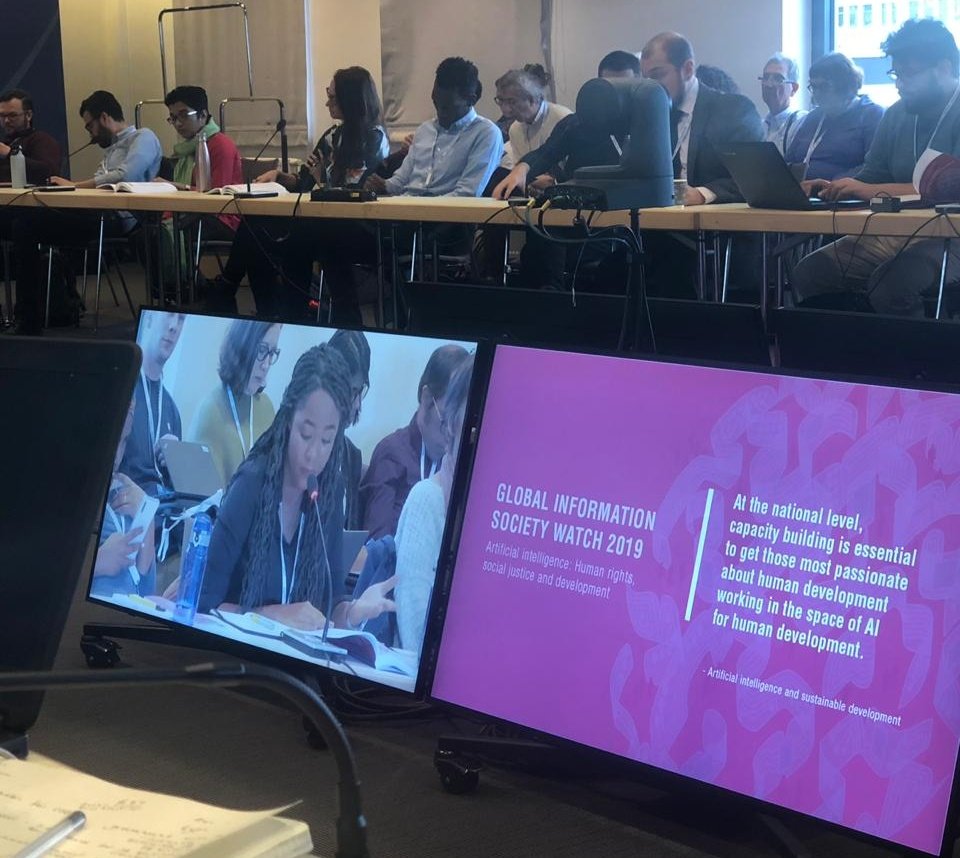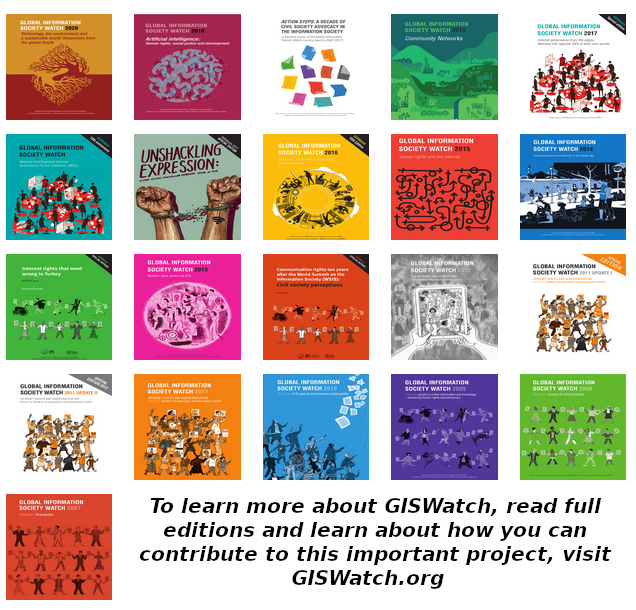
This piece is the second installment of a series celebrating 15 years of APC’s publication, Global Information Society Watch (GISWatch), exploring the origins of this powerful project while looking toward the future. APC's former executive director Anriette Esterhuysen considers how GISWatch has forged its own path by bringing together theory and action, evidence and experience.
I feel so proud of GISWatch. I remember having to be a bit pushy at the start to convince colleagues at APC that we should do it. I also remember arguing with those who felt there was nothing concrete enough to "watch" in the World Summit of Information Society (WSIS) outcomes. In fact, the absence of systematic country-level follow-up mechanisms on WSIS goals – both those in the Geneva Plan of Action and the Tunis Agenda – was one of the primary inspirations for GISWatch. For nearly five years the APC network had invested time and resources in the WSIS process, using it to leverage interest in ICTs for development towards the broader goals of sustainable people-centred development, gender equality, social justice and human rights. To a large extent, civil society inputs were reflected in WSIS outcomes, but it was not at all clear whether civil society would be able to play a systematic role in monitoring implementation (as was the case, for example, with outcomes of the World Conference on Women and the monitoring process facilitated by the Committee on the Status of Women). I had a vision of a GISWatch that monitored achievement of the primary WSIS goal of a people-centred, inclusive and human rights-oriented information society, in the way that Social Watch – an initiative established in 1995 by one of APC’s earliest members, Instituto del Tercer Mundo (ITeM) – monitored fulfilment of national, regional and international commitments to eradicate poverty by governments, the UN system and international organisations.
This vision never quite materialised, partly because we lacked the resources to develop a common scorecard and for quantitative research. But, having just looked again at the preface of the first edition (2007), I think GISWatch has stayed true to its foundational goals:
“While we acknowledge the enormous importance and legitimacy of multilateral governmental commitments, particularly those negotiated under the umbrella of the United Nations, we do not necessarily agree to all of their terms and formulations. Thus, for example, the very concept of the ‘information society’, which is so widely used and features in the title of this publication, is not without controversy, and we approach it with caution. It is a term that tends to de-emphasise social inequality, power and access to resources. Similarly, we find that the concept of the ‘digital divide’ reduces structural differences in access to power and decision making to the level of ‘technology haves and have-nots’. Different degrees of access to technology and connectivity mirror the social and economic divides within countries and between countries. Increase in access to ICTs will not, by itself, reduce poverty or secure freedoms on a sustainable basis. But there is a real danger that lack of access to ICTs, and to the spaces where decisions are made about information and communications infrastructure, content and services, can deepen existing social exclusion and create new forms of exclusion. It is in this context that we believe it is essential for civil society networks to participate in and watch over ICT policy processes at the global, regional and national levels.” [1]
Reading this again, 15 years later, it is also striking that while so much has changed, so much still remains the same; and that the need for GISWatch, and the people and organisations who contribute to it, is as pressing now as it was in 2007.
GISWatch editor Alan Finlay once described GISWatch as being like a “rough guide” to the information society from a civil society perspective – but one written by those living in the country they are talking about, and who get to see the impact of technology on their lives and in their countries first-hand. I think it is a great description. It illustrates that GISWatch content is shaped by context, by the voices and priorities of those who write the country reports. At the same time, it reflects that global nature of the information society (a term now replaced by digitalisation or “digital society”) in the analyses contained in thematic and regional reports.
Alan Finlay is, in my view, the key to GISWatch's success. He brought to it just the right mix of expertise (as a journalist and an editor) and the "distance" that we (APC policy advocacy people) lacked. He found a way of making it work as research, analysis, advocacy and narrative through its documentation of experience.
Others who helped make GISWatch stay alive and thrive during the time I was still playing an oversight role (until 2017) include Willie Currie, APC’s policy manager at the time we started; Karen Higgs, then APC’s communications manager; and Karen Banks, who coordinated APC’s participation in the WSIS. Later Natasha Primo brought academic rigour to the process and Roxana Bassi created much-needed coordination and online publishing expertise. Valeria Betancourt has kept GISWatch going and growing, working with APC’s fantastic communications team. But so many people have left their mark on GISWatch, and I feel very privileged to have worked with them. Human rights experts Joy Liddicoat and Deborah Brown; APC techie and comms manager Mallory Knodel, who stayed with the project even after she left APC; Pablo Accuosto from ITeM, whose subtle and sharp analysis enriched the first few editions; and Monique Doppert from Hivos, who really believed in the project, and helped with fundraising during lean periods. David Souter was there at the outset – playing devil’s advocate when needed but always providing a holistic perspective, countering the tech exceptionalism so many of us struggle to break away from. Amy Mahan, a colleague and a friend, contributed to the first two editions with the third (2009) dedicated to her, as it was published not long after Amy, only 47 years old, died of cancer.

Some of the goals I had for GISWatch have not materialised – e.g. having every single APC member participate and having a living online "watch" index to capture civil society perspectives, by country, on the people-centred information society (like the old CIVICUS civil society index). But what was achieved was not any less meaningful than that, and I know from experience that at least 25% of my ideas turn out to be either not very good, or just not feasible. :-)
In fact, it has probably achieved more. It is just different, and it found its own path. The network of authors complements the APC member network. Special editions of GISWatch with in-depth country and thematic reports play the dual role of communicating the work of APC members, projects and programmes, while also building the evidence and knowledge needed to make this work more effective. I think this is what happens with truly great and well-managed projects – the ability to adapt, to shift the small and specific goals, while keeping focused on the larger, more important goals. In this case it is the continuity, the learning that it has provided to every report writer, the historical overview it provides of what has changed, and what has not.

Some of what was in the original GISWatch vision is now in the Internet Universality Indicators – another indicator of how good projects work. They feed, directly and indirectly, into other good projects.
In his recent blog post, "This journey has shaped how I frame the internet's role in our lives", Alan captures the “message” that civil society conveys through GISWatch brilliantly: “‘Don’t let businesses and governments decide what happens next; pay attention to the needs and concerns of the marginalised, vulnerable and poor; care about local experiences.’” If you want to make the information society equitable, authors said, make policy processes participatory, “‘let us collectively shape how the internet can evolve.’”
[Video: GISWatch launch, Internet Governance Forum 2016]
I would add that GISWatch represents, for me, the notion of “praxis”. It brings together theory and action; evidence and experience. Through its content and its authors, and the organisations and networks they are part of, it moves beyond protest and critique into what the philosopher Taiwo Olufemi talks about in an interview on his latest book, Elite Capture: How the Powerful Took Over Identity Politics (and Everything Else):
“What I’m trying to get at with constructive politics [...] is that I don’t think we can protest our way to a better social structure. I don’t think we can critique our way to better ideas. I don’t think we can destroy our way to a better world. I’m encouraged by the work people are doing to build things: workers building unions, people building resilient food systems outside the control of corporations, communities building non-carceral strategies for preventing and responding to harm.” [2]
GISWatch country reports are filled with descriptions of the work people are doing to “build things”. GISWatch links critical thinking and analysis to concrete proposals for change, and to stories of how people and communities are building this change themselves. It does not shy away from analysing structural inequality and concentration of economic and geopolitical power, but it always recognises that people in the global South – be they civil society activists, community networks, regulators or governments – have agency, and that agency links to action, responsibility and accountability.
Congrats to every person who has ever been part of GISWatch.
Notes:
[1] An extract from the preface I wrote for the first edition of GISWatch in 2007: https://giswatch.org/index.php/report-introduction/2007-focus-participation/preface-2007-report
[2] From an interview with Claire Schwartz published in Jewish Currents on 3 May 2022: https://jewishcurrents.org/assuming-the-perspective-of-the-ancestor
GISWatch 15th anniversary series
- Part I: This inaugural piece by long-time GISWatch editor Alan Finlay is the first in a series that celebrates and examines how far we've come and where we need to head next. Read more.
- Part II: This second installment by APC's former executive director Anriette Esterhuysen considers how GISWatch has forged its own path by bringing together theory and action, evidence and experience. Read more.
- Part III: This third installment explores reflections of what it means to write for this long-running project with Y. Z. Ya'u, a long-time Nigeria-based contributor to the report. Read more.
- Part IV: The fourth installment examines how the initial support for GISWatch led to a strong and impactful collaboration with the Swedish International Development Cooperation Agency. Read more.
- Part V: This the fifth installment connects us with Pablo Accuosto, the project's first coordinator, who explains how GISWatch developed into a groundbreaking publication and fundamental source of information. Read more.
- Part VI: The sixth installment comes from Florencia Roveri, a long-standing author from Nodo TAU who has been contributing significantly to Argentina country reports since the inception of GISWatch. Read more.
- Part VII: The seventh installment considers the reflections of researchers around the globe who have contributed to the report year after year, including the latest edition, GISWatch 2021-2022: Digital futures for a post-pandemic world. Read more.
